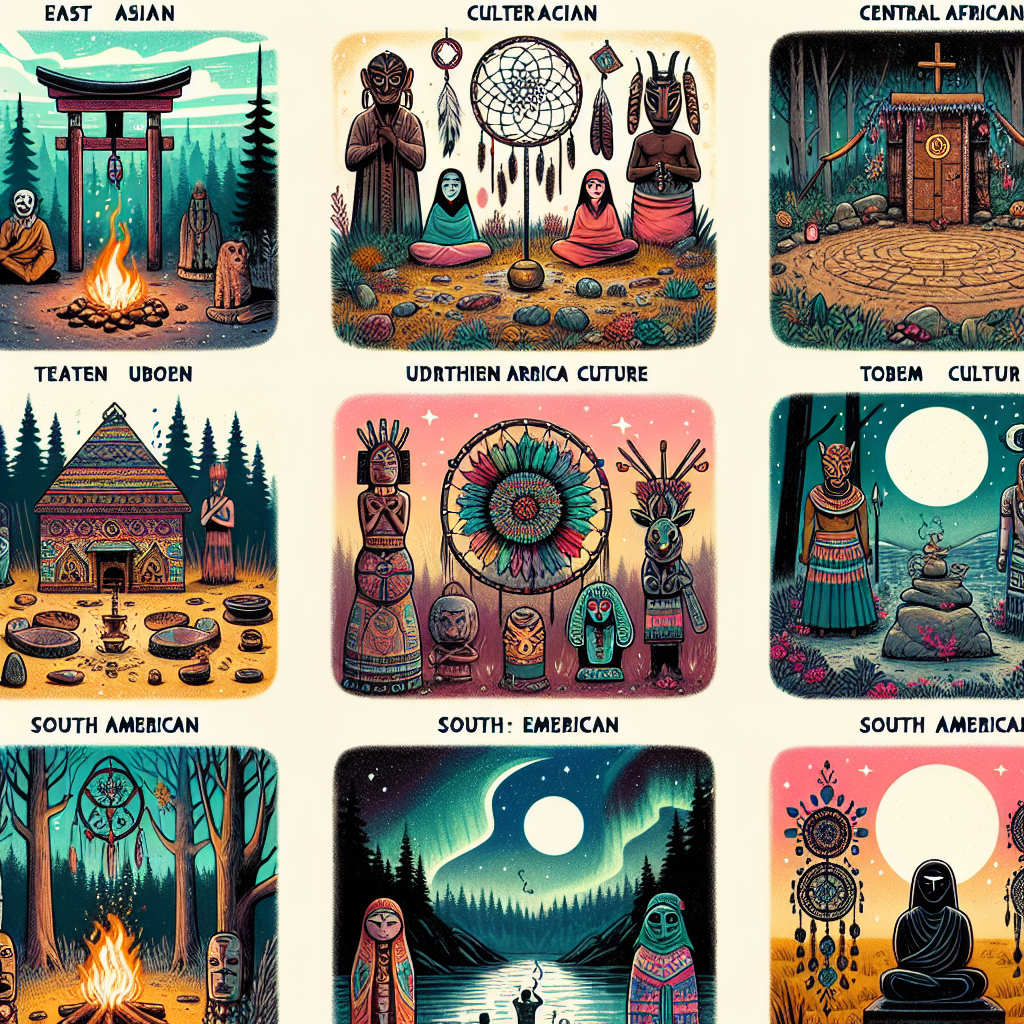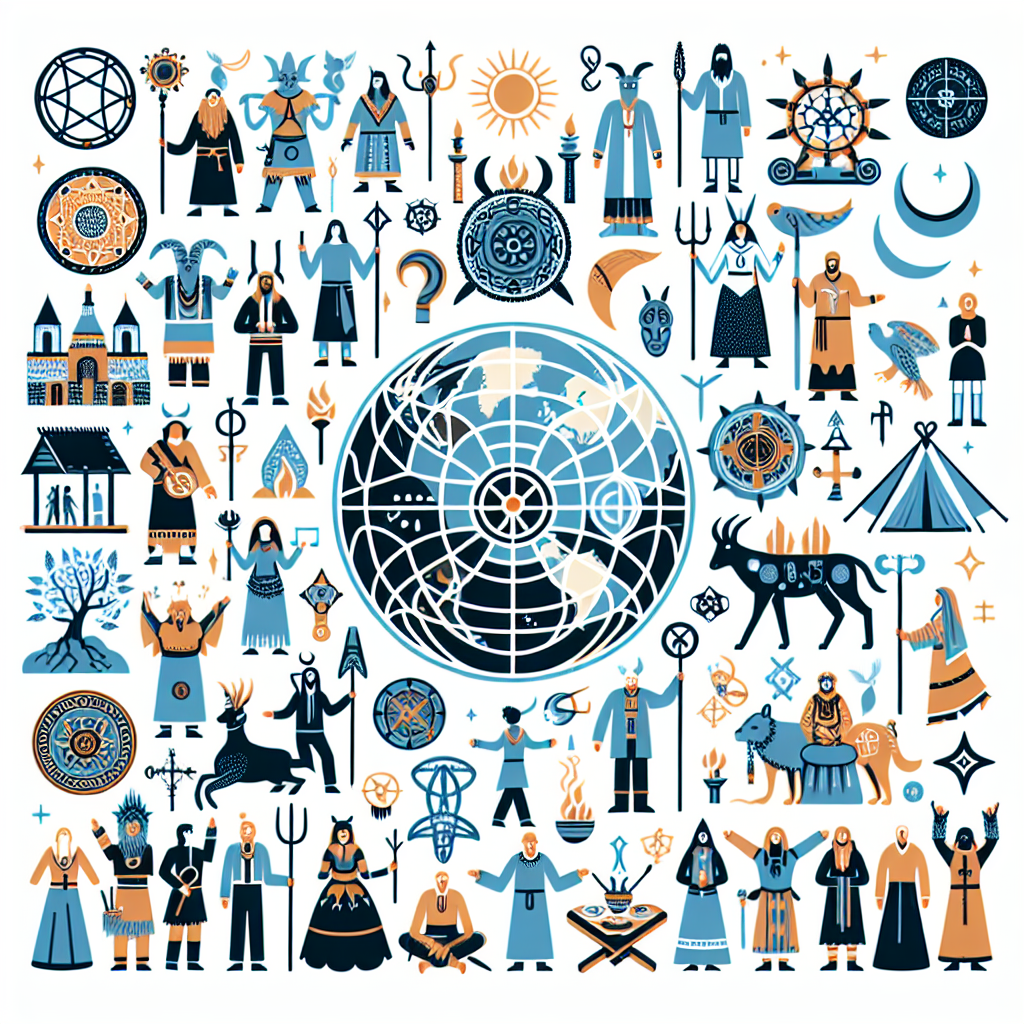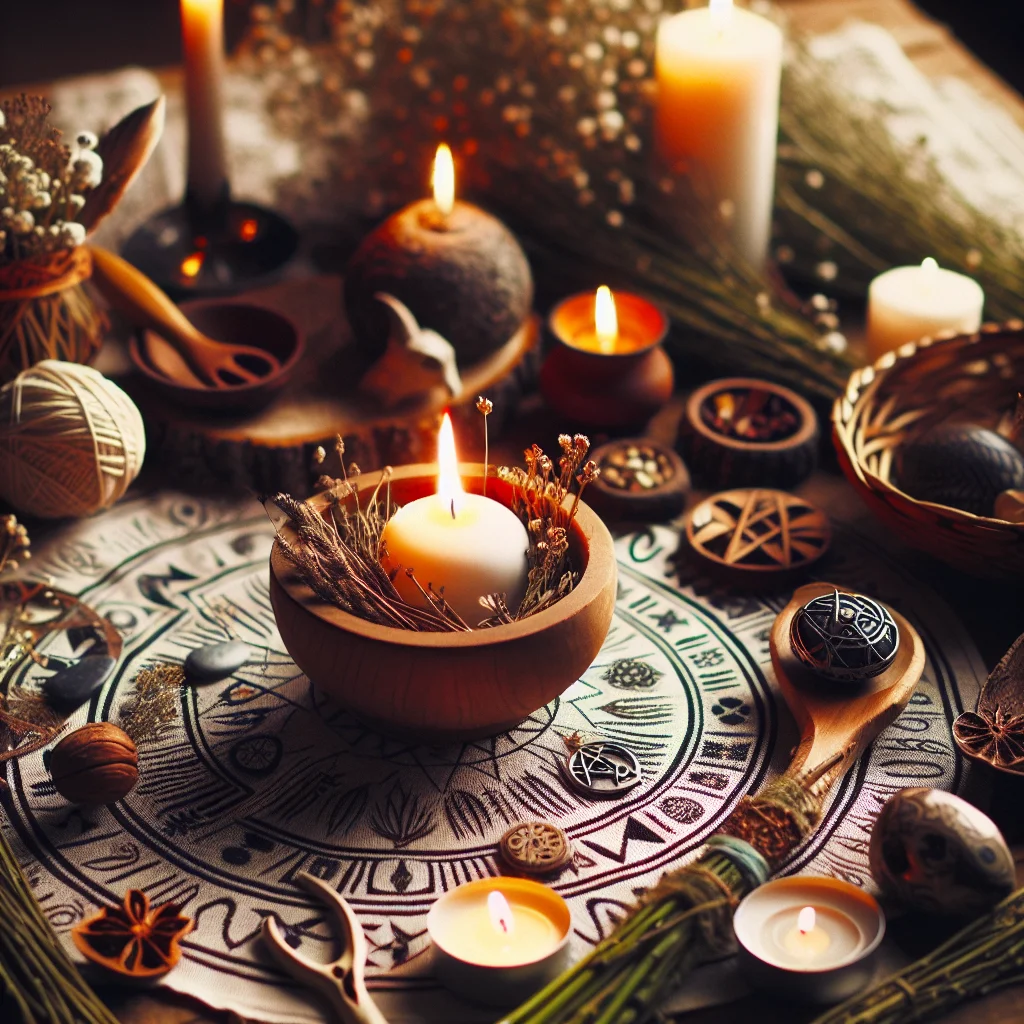As an Amazon Associate I earn from qualifying purchases.

u003cH2u003eIntroduction to Pagan Traditionsu003c/H2u003e
Paganism, often characterized by its nature-centric beliefs and practices, spans a myriad of cultures and historical backgrounds. With its roots stretching back to ancient civilizations, pagan traditions have influenced numerous aspects of modern spirituality and religion. Today, millions of people around the world still celebrate these traditions, showcasing the lasting impact of these ancient practices.
u003cH3u003eCeltic Paganismu003c/H3u003e
Celtic Paganism, also known as Druidry, is centered around the reverence of nature, particularly trees, and involves a variety of rituals to honor deities associated with natural elements. Druids, the spiritual leaders in this tradition, played a crucial role in the societal and religious aspects of ancient Celtic tribes.
u003cH3u003eNorse Paganismu003c/H3u003e
Norse Paganism, or Heathenry, hails from the ancient Norse people. Adherents worship gods like Odin and Thor and celebrate festivals such as Yule, which carries over to some modern Christmas traditions. Blót, a ritual sacrifice, is a key component of their religious observance.
u003cH3u003eGreek Paganismu003c/H3u003e
Greek Paganism, rooted in the religion of ancient Greece, centers on the worship of the pantheon of Olympian gods such as Zeus, Athena, and Apollo. The tradition involves elaborate myths and complex rituals, many of which have left a profound influence on Western culture.
u003cH3u003eRoman Paganismu003c/H3u003e
Roman Paganism, similar to Greek traditions, worships a pantheon of gods like Jupiter and Mars, and involves rituals that were often state-sponsored to ensure the favor of the deities. The Roman calendar was filled with festivals, many of which have inspired modern Western holidays.
u003cH3u003eEgyptian Paganismu003c/H3u003e
Egyptian Paganism focuses on a diverse array of gods and goddesses such as Ra, Isis, and Osiris. Practices often involved elaborate burial rituals aimed at ensuring a safe passage to the afterlife. The monumental architecture, like the pyramids, underscores the importance placed on religion.
u003cH3u003eSlavic Paganismu003c/H3u003e
Slavic Paganism reveres gods connected to natural elements and ancestors. Key deities include Perun, the thunder god, and Mokosh, the earth goddess. Festivals like Kupala Night celebrate the natural cycles and involve rituals to promote fertility and prosperity.
u003cH3u003eAfrican Traditional Religionsu003c/H3u003e
African Pagan traditions are highly diverse, reflecting the continents vast cultural mosaic. These religions typically involve ancestor worship and a belief in a myriad of spirits and deities. Rituals often include music, dance, and sacrifices to honor these spirits and seek their guidance.
u003cH3u003eNative American Paganismu003c/H3u003e
Native American Paganism is richly varied across different tribes, but commonly features a profound spiritual connection to the land, animals, and ancestors. Practices include vision quests, sweat lodges, and ceremonies like the Sun Dance, all aimed at maintaining harmony with the natural world.
u003cH3u003eHinduism (pre-Vedic)u003c/H3u003e
Pre-Vedic Hinduism involves the worship of nature and fertility deities such as the Mother Goddess. The Indus Valley Civilization, one of the world’s oldest, practiced rituals that laid the foundation for what would become a complex, polytheistic belief system with a significant impact on Indian culture.
u003cH3u003eShintou003c/H3u003e
Shinto, native to Japan, focuses on kami, spirits associated with natural elements and ancestors. Shrines dedicated to these spirits dot the Japanese landscape, and rituals include offerings, purification rites, and festivals like Matsuri, which seek to honor and please the kami.
### 10 Pagan Traditions Across Different Cultures
Pagan traditions have existed for millennia, deeply rooted in the customs of diverse cultures across the globe. Here, we explore 10 distinct forms of cultural Paganism that showcase the rich diversity of Pagan customs and belief systems.
#### 1. **Norse Paganism (Asatru)**
Norse Paganism, also known as Asatru, is practiced primarily in Scandinavian countries like Iceland, Norway, and Sweden. It is characterized by a pantheon of gods and goddesses such as Odin, Thor, and Freyja. Norse Pagans celebrate seasonal festivals like Yule and Midsummer, and their rituals often involve blóts (sacrifices) to honor these deities.
#### 2. **Hellenic Paganism**
Revived modern worship of ancient Greek gods and goddesses is referred to as Hellenic Paganism. Practitioners honor Zeus, Hera, Apollo, and other deities through rituals that include offerings of food, wine, and incense. Celebrations like the Hellenion and the Panathenaia are central to this tradition.
#### 3. **Celtic Paganism**
Celtic Paganism is predominantly observed in Ireland, Scotland, and Wales, celebrating deities like the Dagda, Brigid, and Lugh. Key festivals, known as Sabbats, include Samhain, Imbolc, Beltane, and Lughnasadh. These festivals often involve bonfires, feasts, and traditional music and dance.
#### 4. **Slavic Paganism (Rodnovery)**
Rodnovery is the modern religious movement that attempts to revive the pre-Christian Slavic religion. Practiced in countries such as Russia, Poland, and Ukraine, it venerates gods like Perun, Veles, and Mokosh. Rituals often include community gatherings and offerings of bread, grains, and mead.
#### 5. **Roman Paganism**
Practiced mainly in Italy and contemporary followers worldwide, Roman Paganism pays homage to deities like Jupiter, Mars, and Venus. Festivals such as Saturnalia, Lupercalia, and Vinalia celebrate seasonal changes and agricultural cycles, usually involving sacrifices, prayers, and public games.
#### 6. **Shinto (Kami-no-michi)**
Shinto, the indigenous spirituality of Japan, centers around the worship of kami (spirits or gods). Rituals called matsuri are held at Shinto shrines to honor kami associated with natural features or historical figures. Important events in the Shinto calendar include the New Year (Shogatsu) and the Obon festival.
#### 7. **Native American Spirituality**
Native American Paganism encompasses a variety of beliefs and practices among different tribes. The Lakota, for example, have rituals like the Sun Dance, which involves fasting and dancing to connect with the Great Spirit. The Navajo celebrate the Night Chant, a healing ceremony that lasts up to nine days.
#### 8. **African Traditional Religions**
In sub-Saharan Africa, cultures like the Yoruba and the Zulu follow rich Pagan customs. The Yoruba people of Nigeria worship deities called Orishas through elaborate ceremonies involving drumming, dance, and offerings. Zulu rituals include honoring ancestors through animal sacrifices and feasts.
#### 9. **Australian Aboriginal Spirituality**
Australian Aboriginal Paganism is grounded in the concept of the Dreamtime, a spiritual worldview that encompasses creation myths, ancestral beings, and sacred landscapes. Songlines, storytelling, and totemic rituals are essential components of Aboriginal spiritual practice.
#### 10. **Hinduism (Folk Hinduism)**
While Hinduism is predominantly recognized as a major religion, it also has Pagan elements in its folklore and rural practices. Deities like the village goddess Mariamman in South India or forest spirits are often worshipped alongside mainstream gods. Rituals include offerings of flowers, coconuts, and food, accompanied by community feasts and dances.
A global survey conducted by the International Religious Freedom Report highlights that 6% of the world’s population identifies with some form of Pagan or folk religion. Pagan diversity and customs continue to thrive and adapt, integrating ancient practices with modern spiritual needs.
Celtic Paganism: Connection with Nature
My visits to the ancient stone circles in Ireland were profound. Standing among those ancient rocks, I felt an undeniable connection with the earth, a sense of unity that the Celts must have worshipped. The stories told by local historians added depth to this experience, highlighting how deeply intertwined the Celts were with the natural world.
During the Beltane festival in Scotland, I witnessed a vibrant celebration of life and fertility. The air was thick with the smell of burning wood and the sounds of traditional music. Participants danced around Maypoles, reenacting rituals intended to bring prosperity and good health. I participated in some of the dances, feeling a collective energy that was both invigorating and comforting.
One clear evening, I joined a small group for a Druidic ritual in a secluded forest. The leader invoked various gods and spirits, expressing gratitude for their blessings. Amidst the candlelight and the rustling leaves, I felt an intense and personal spiritual awakening. Here, nature wasn’t just a backdrop; it was a sacred force to be revered and honored.
Egyptian Paganism: Reverence for the Divine
Visiting the temples of Luxor and Karnak, I was struck by the grandeur that surrounded Egyptian spirituality. The gods were omnipresent and their reverence was palpable in the awe-inspiring architecture. As I walked through the halls adorned with intricate carvings, I marveled at the ancient Egyptians’ dedication to their deities.
I had the opportunity to attend a modern ceremonial reenactment of the Festival of Opet in Cairo. The procession included elaborately dressed participants who invoked various deities, particularly Amon-Ra. The rich symbolism and the fervent dedication of the participants provided a strong sense of how valued divine favor was in ancient Egypt.
A memorable experience was visiting the ruins of the Temple of Isis on Philae Island. Standing near the sacred lake, I learned about the rituals performed for Isis, who was considered a divine nurturer. The stories of her wisdom and compassion resonated deeply with me, giving insight into the emotional and spiritual depth of Egyptian Paganism.
Hindu Paganism: A Spiritual Journey
My pilgrimage to Varanasi, one of the holiest cities in Hinduism, was a journey of spiritual enlightenment. Observing the daily rituals by the Ganges River, I saw devotees performing aarti and making offerings to the river, which they consider a goddess. The deep spiritual intensity and the rich traditions left a lasting impression.
While staying in a small village in Rajasthan during Diwali, I was invited to join a family in their Laxmi Puja. The rituals were elaborate, filled with chants, incense, and offerings to the goddess of wealth. The sense of devotion and familial unity was touching, reflecting how ingrained these practices are in daily life.
Participating in a Holi celebration in Mathura was a burst of color and joy. This festival, which celebrates the triumph of good over evil and the arrival of spring, exemplified the Hindu reverence for the cyclical nature of life. The exuberance of the participants, combined with the spiritual undertones, made it a deeply meaningful experience.
Shinto: Harmony with the Kami
A visit to the Fushimi Inari Shrine in Kyoto offered profound insights into Shinto practices. Walking through the red torii gates, I felt a deep meditative peace. Each gate, an offering to Inari, the deity of rice and fertility, spoke to the way Shinto harmonizes with natural and spiritual realms.
During the New Year festivities at the Itsukushima Shrine on Miyajima Island, I witnessed a blend of traditional rituals and modern celebrations. The entire community participated, showing respect to the kami through offerings and prayers. The communal spirit and respect for nature encapsulated the essence of Shinto belief.
Participating in a local Matsuri in Tokyo, dedicated to a neighborhood deity, was a vibrant cultural immersion. With drums, chants, and intricate dances, the festival was a dynamic expression of gratitude to the kami. The local community’s active involvement demonstrated how Shinto seamlessly integrates spiritual reverence into everyday life.
u003ch2u003eFAQ 1: What is Paganism?u003c/h2u003e
u003cpu003ePaganism is a term used to describe various religious traditions that are polytheistic, nature-focused, and often follow ancient practices. These traditions can vary widely across different cultures and can include practices such as worshiping multiple gods or goddesses, celebrating seasonal festivals, and honoring nature.u003c/pu003e
u003ch2u003eFAQ 2: Are all Pagan traditions the same?u003c/h2u003e
u003cpu003eNo, Pagan traditions are diverse and vary significantly across different cultures. Each tradition has its own unique beliefs, practices, and customs. For example, Norse Paganism involves the worship of gods like Odin and Thor, while Celtic Paganism may focus on deities such as Brigid and Lugh.u003c/pu003e
u003ch2u003eFAQ 3: What are some common Pagan customs?u003c/h2u003e
u003cpu003eCommon Pagan customs often include rituals and ceremonies tied to nature and the changing seasons, such as solstice and equinox celebrations. Many Pagan traditions also feature rituals involving offerings to gods or spirits, ancestor worship, and sacred rites for significant life events like birth, marriage, and death.u003c/pu003e
u003ch2u003eFAQ 4: How do modern Pagans practice their faith?u003c/h2u003e
u003cpu003eModern Pagans may practice individually or as part of a Pagan community. They often celebrate festivals, engage in rituals, and follow ethical teachings derived from their respective traditions. Some modern Pagans adapt ancient practices to fit contemporary lifestyles, while others strictly adhere to historical rituals.u003c/pu003e
u003ch2u003eFAQ 5: Is Paganism recognized as a religion?u003c/h2u003e
u003cpu003eYes, Paganism is recognized as a legitimate religion in many parts of the world. It includes various traditions such as Wicca, Druidry, Heathenry, and other polytheistic and nature-based faiths. Recognition can differ by country and jurisdiction.u003c/pu003e
u003ch2u003eFAQ 6: What cultures have significant Pagan traditions?u003c/h2u003e
u003cpu003eSignificant Pagan traditions can be found in many cultures around the world, including Norse (Scandinavian), Celtic, Greco-Roman, Native American, and African traditions. Each culture has its own distinct set of deities, rituals, and beliefs that fall under the umbrella of Paganism.u003c/pu003e
u003ch2u003eFAQ 7: How do Pagans view nature?u003c/h2u003e
u003cpu003eNature holds a central place in most Pagan traditions. Pagans often see nature as sacred and imbued with spiritual significance. They may practice rituals outdoors, honor natural cycles like the lunar phases and seasons, and strive for ecological harmony.u003c/pu003e
u003ch2u003eFAQ 8: Can I practice Paganism if I don’t belong to a specific culture?u003c/h2u003e
u003cpu003eYes, many modern Pagans do not belong to the specific cultures from which these traditions originate. They may choose to follow a particular tradition that resonates with them or create a personal practice that incorporates elements from various Pagan customs. However, it’s important to approach this practice with respect and cultural sensitivity.u003c/pu003e
u003ch2u003eFAQ 9: What is cultural appropriation in the context of Paganism?u003c/h2u003e
u003cpu003eCultural appropriation occurs when elements of a culture, especially those of marginalized groups, are taken and used outside of their original context in an insensitive or exploitative manner. In Paganism, this can happen when individuals adopt practices or symbols without understanding or respecting their cultural significance. It’s crucial to engage with these traditions respectfully and mindfully.u003c/pu003e
u003ch2u003eFAQ 10: How can I learn more about different Pagan traditions?u003c/h2u003e
u003cpu003eYou can learn more about Pagan traditions through books, online resources, lectures, and by connecting with local Pagan communities or groups. Attending Pagan festivals and rituals, as well as speaking with practicing Pagans, can also provide valuable insights into different customs and beliefs.u003c/pu003e

## Conclusion
Across diverse cultures, Pagan traditions reveal a rich tapestry of beliefs and practices deeply rooted in the natural world and ancient customs. From the Norse pantheon’s reverence for deities like Odin and Thor to the Celtic festivals celebrating seasonal cycles, these traditions emphasize a profound connection with nature and its cycles. In African Paganism, the Yoruba religion showcases intricate rituals and deities like Orunmila, underscoring the cultural importance of divine intercession in daily life. Similarly, Indigenous cultures in the Americas integrate spirituality closely with the land, honoring spirits and ancestors through rituals and storytelling that preserve their heritage.
Paganism’s diversity reflects the adaptability and resilience of these spiritual paths. Japanese Shintoism, for instance, venerates kami spirits that inhabit natural elements, illustrating how Pagan customs can be woven into the fabric of a country’s dominant religion. Meanwhile, the syncretic nature of Western Paganism, blending elements from various mythologies and spiritual traditions, highlights a global resurgence and reinterpretation of ancient practices. These cultural manifestations of Paganism, whether through the celebration of solstices, the veneration of deities, or the practice of magic and divination, underscore a universal quest for meaning and connection to the cosmos. Through this intricate mosaic of customs and beliefs, the enduring legacy of Pagan traditions continues to inspire and evolve across the globe.
Amazon and the Amazon logo are trademarks of Amazon.com, Inc, or its affiliates.


